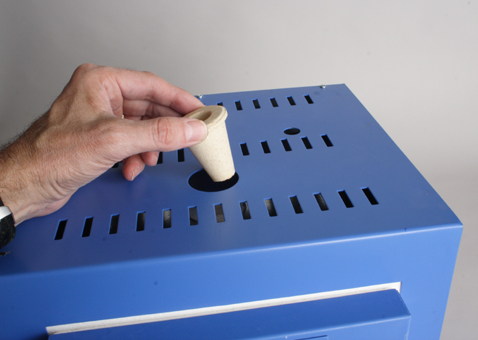 |
|
|
Kiln Pointers
|
|
|
Firing Cork Clay |
CONTENTS Firing Cork Clay Reader Response: New factory manager; keeping moisture out of the kiln Recent Q&As: The meaning of “Idle” in a digital kiln display A Kiln Story: Ron Grove’s Digital Controller Memorable Quote ----------- FIRING CORK CLAY Cork clay is a filler used to create hollow shapes with PMC and Art Clay Silver (brands of silver clay). After creating the shape with cork clay, allow it to dry for at least 24 hours. Do not force-dry the cork clay with a heat gun. Then coat the cork clay with PMC or Art Clay Silver. Cork clay and silver clay are fired in small jewelry kilns such as the SC-2. Fire cork clay in a well ventilated area. Open windows and circulate the air with a fan. You may want to use an overhead vent hood that is ducted to a nearby window. Or fire the kiln on an open, covered porch. Keep the kiln door closed between 500° - 800°F / 260° - 426°C. This is to prevent the cork from flaming out. Fire no faster than 1500F / 833C per hour to give the cork enough time to burn out. Leave the kiln’s vent plug out from the beginning until around 800 °F / 426°C. Hold at that temperature for 1 hour. After the hold, insert the vent plug and continue to fire the silver clay to the clay manufacturer’s recommended temperature. Caution: When venting materials such as cork clay, remove the vent plug at the beginning of the firing. Removing it later during the firing may cause the organic materials to flame up for a moment. (If you forgot to vent the kiln at the beginning of the firing, do not remove the plug later.) If you ever remove the vent plug and the cork clay flames up, keep the kiln door closed so the flames can die out safely. Do not fire cork clay in a microwave kiln (the type that is placed inside a household microwave oven). The microwave kiln fires too fast to properly burn out the cork. Cereal, pasta, and bread are other good core materials. Do not use wax or Styrofoam as a core. They emit harmful fumes. ----------- READER RESPONSE In the last Kiln Pointer, I announced that Maria Garcia was our new factory manager. Tony Rodriguez of San Antonio, Texas wrote, “I love to know about the personnel changes in the plant. I always felt part of the family there.” A recent Kiln Pointer was entitled “Keep the Kiln Lid Closed Between Firings.” David Kittrell of Kittrell/Riffkind Art Glass in Dallas, Texas wrote, “In this period of high humidity, a closed lid might also keep your kiln interior a little drier. The shelves seem to collect moisture, and if you don't heat them before fusing, they can cause bubbles in the art. If I remember correctly, within a county of us either way, in a week, we had tornadoes, floods, a terrorist attack and an earthquake. That would be Texas for you.” ----------- RECENT Q&As Q. What does IdLE shown in a digital kiln temperature display stand for? A. Most controllers use a 14-segment display (also called a "star burst"), so the display does not show lower and upper case letters. IdLE looks cryptic, but it actually just means "idle," like a car engine that idles at a stop light. At idle, the kiln is ready to be programmed or to begin firing. ----------- A KILN STORY: RON GROVE’S CONTROLLER Not long after he bought Paragon in 1982, John Hohenshelt, Sr. visited temperature controller manufacturers looking for a digital kiln controller. In those days, a digital controller did not exist in the American hobby and studio kiln industry. The price of an industrial controller was higher than the retail price of a Paragon kiln. Eventually John gave up trying to find an affordable controller and hired an engineer named Ron Grove to design one. When Ron became curious about a project, he thought about it obsessively until he finished the design. Ron, an eccentric inventor who worked at Apple in its early days, built a controller that used a telephone keypad. Ron’s controller, the DTC 100C, became the first in the American hobby and studio kiln market. We made it here in the factory. People still call us with questions about their simple but venerable DTC 100C. ----------- MEMORABLE QUOTE “Everything around you that you call life was made up by people that were no smarter than you. You can change it, you can influence it, you can build your own things that other people can use.” Steve Jobs ----------- Time management can be distilled to one sentence: Pick out an item on your to-do list, and work on that task until it is finished. My distillation of time management comes from reading many books on the topic and listening to hours of podcasts. By far, I accomplish the most when I just stick with one task. The new Paragon plant manager, Maria Garcia, calls this “staying on task.” Thank you, With best wishes, Arnold Howard Paragon Industries, L.P. – Better Designed Kilns 2011 South Town East Blvd., Mesquite, Texas 75149-1122 Voice: 972-288-7557 & 800-876-4328 / Fax: 972-222-0646 / ahoward@paragonweb.com / www.paragonweb.com / www.facebook.com/paragonkilns PRIVACY NOTICE: Under no circumstance do we share or sell your email address. Copyright 2015, by Paragon Industries, L.P. |
|
|

|
|
|
|
|
“Custom and standard Kilns and Industrial Furnaces for ceramics, pottery, heat treating, enameling, |
||||
